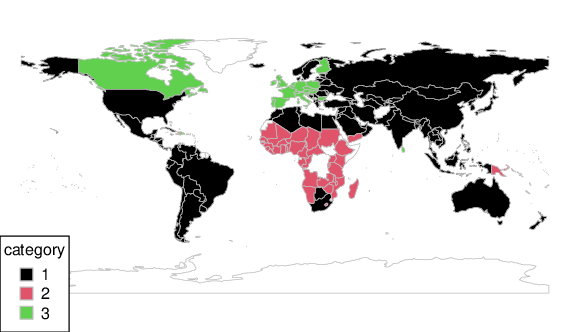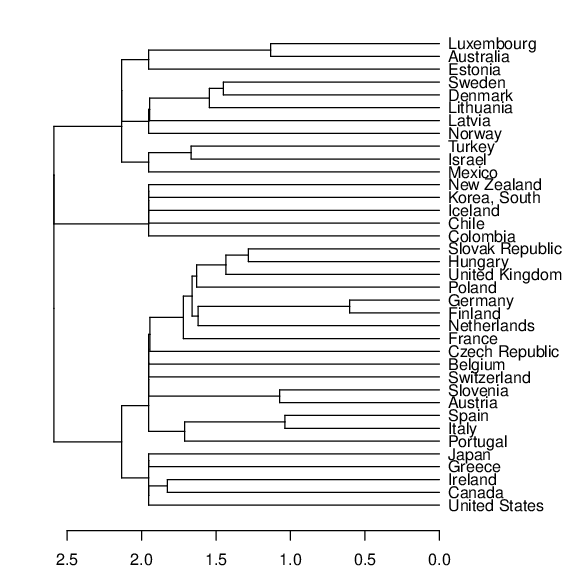R Interface Examples¶
The latest stable release of the R package genieclust is available from the CRAN repository. We can install it by calling:
install.packages("genieclust")
Below are a few basic examples of how to interact with the package.
library("genieclust")
Let’s take the Sustainable Society Indices dataset that measures the Human, Environmental, and Economic Wellbeing in each country. There are seven categories on the scale \([0, 10]\).
# see https://github.com/gagolews/genieclust/tree/master/devel/sphinx/weave
ssi <- read.csv("ssi_2016_categories.csv", comment.char="#")
X <- as.matrix(ssi[,-1]) # everything except the Country (1st) column
dimnames(X)[[1]] <- ssi[,1] # set row names
head(X) # preview
## BasicNeeds PersonalDevelopmentAndHealth WellBalancedSociety
## Albania 9.6058 7.9596 6.9926
## Algeria 9.0212 7.3365 4.2039
## Angola 5.9728 5.6928 2.1401
## Argentina 9.8320 8.3506 3.8952
## Armenia 9.4469 7.4205 6.2892
## Australia 10.0000 8.5909 6.1055
## NaturalResources ClimateAndEnergy Transition Economy
## Albania 6.6343 4.6217 2.1025 3.0565
## Algeria 5.2772 2.6627 3.0741 6.1543
## Angola 6.7594 6.2122 1.8988 3.7535
## Argentina 5.4535 3.3003 6.3899 5.3406
## Armenia 6.4363 2.8543 2.4342 3.8296
## Australia 4.1307 1.6278 7.5395 7.5931
The API of genieclust is compatible with R’s workhorse
for hierarchical clustering, stats::hclust().
Yet, for efficiency reasons, it is better to feed genieclust::gclust()
with the input matrix directly:
# faster than gclust(dist(X)):
h <- gclust(X) # default: gini_threshold=0.3, distance="euclidean"
print(h)
##
## Call:
## gclust.mst(d = mst.default(d, distance = distance, verbose = verbose, ...), gini_threshold = gini_threshold, verbose = verbose)
##
## Cluster method : Genie(0.3)
## Distance : euclidean
## Number of objects: 154
In order to extract a desired k-partition, we can call stats::cutree():
y_pred <- cutree(h, k=3)
sample(y_pred, 25) # preview
## Iran Slovenia Morocco
## 1 3 1
## Trinidad and Tobago Sierra Leone Colombia
## 1 2 1
## Turkmenistan Syria Nigeria
## 1 1 2
## Tunisia Ghana Sweden
## 1 2 1
## Netherlands Bhutan Mexico
## 3 1 1
## Jamaica Saudi Arabia Hungary
## 1 1 3
## Peru Kazakhstan Spain
## 1 1 3
## Japan Korea, North China
## 1 1 1
## Liberia
## 2
This gives the cluster IDs allocated to each country. Let’s depict the obtained partition using the rworldmap package:
library("rworldmap") # see the package's manual for details
mapdata <- data.frame(Country=dimnames(X)[[1]], Cluster=y_pred)
mapdata <- joinCountryData2Map(mapdata, joinCode="NAME", nameJoinColumn="Country")
mapCountryData(mapdata, nameColumnToPlot="Cluster", catMethod="categorical",
missingCountryCol="white", colourPalette=palette.colors(3, "R4"),
mapTitle="")

Figure 16 Countries grouped with respect to the SSI categories¶
We can compute, for instance, the average indicators in each identified group:
t(aggregate(as.data.frame(X), list(Cluster=y_pred), mean))[-1, ]
## [,1] [,2] [,3]
## BasicNeeds 9.0679 5.2689 9.8178
## PersonalDevelopmentAndHealth 7.5081 5.9312 8.2995
## WellBalancedSociety 4.8869 2.8682 6.8272
## NaturalResources 5.6633 7.0040 6.3743
## ClimateAndEnergy 3.6241 7.0818 3.5947
## Transition 4.0749 2.6300 7.3402
## Economy 5.5127 3.5411 4.2742
Dendrogram plotting is also possible. For greater readability, we will restrict ourselves to a smaller sample; namely, to the 37 members of the OECD:
oecd <- c("Australia", "Austria", "Belgium", "Canada", "Chile", "Colombia",
"Czech Republic", "Denmark", "Estonia", "Finland", "France", "Germany",
"Greece", "Hungary", "Iceland", "Ireland", "Israel", "Italy", "Japan",
"Korea, South", "Latvia", "Lithuania", "Luxembourg", "Mexico", "Netherlands",
"New Zealand", "Norway", "Poland", "Portugal", "Slovak Republic", "Slovenia",
"Spain", "Sweden", "Switzerland", "Turkey", "United Kingdom", "United States")
X_oecd <- X[dimnames(X)[[1]] %in% oecd, ]
h_oecd <- gclust(X_oecd)
plot(as.dendrogram(h_oecd), horiz=TRUE)

Figure 17 Cluster dendrogram for the OECD countries¶
Conclusion:
If we are only interested in a specific partition, calling
genie()directly will be slightly faster than referring tocutree(gclust(...)).genieclust also features partition similarity scores (such as the adjusted Rand index) that can be used as external cluster validity measures.
For more details, refer to the package’s documentation. Also, see the Python examples regarding noise point detection, benchmarking, timing, etc.
To learn more about R, check out Marek’s open-access textbook Deep R Programming [6].